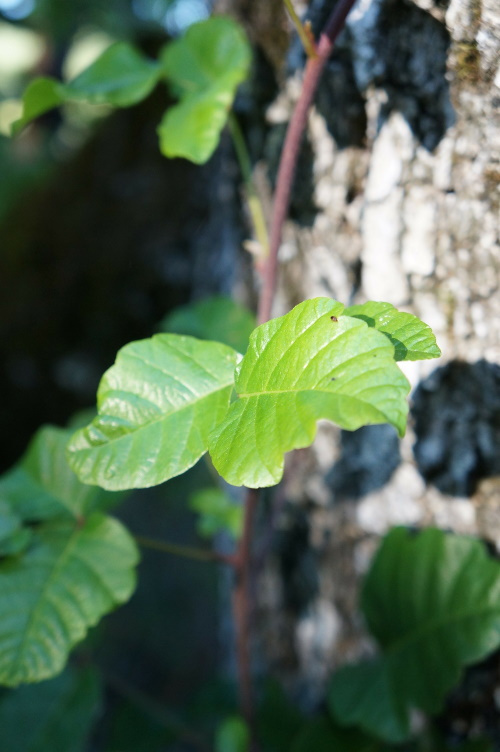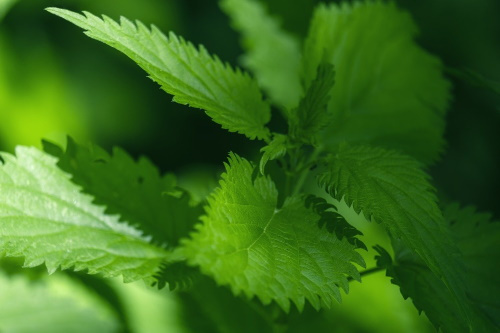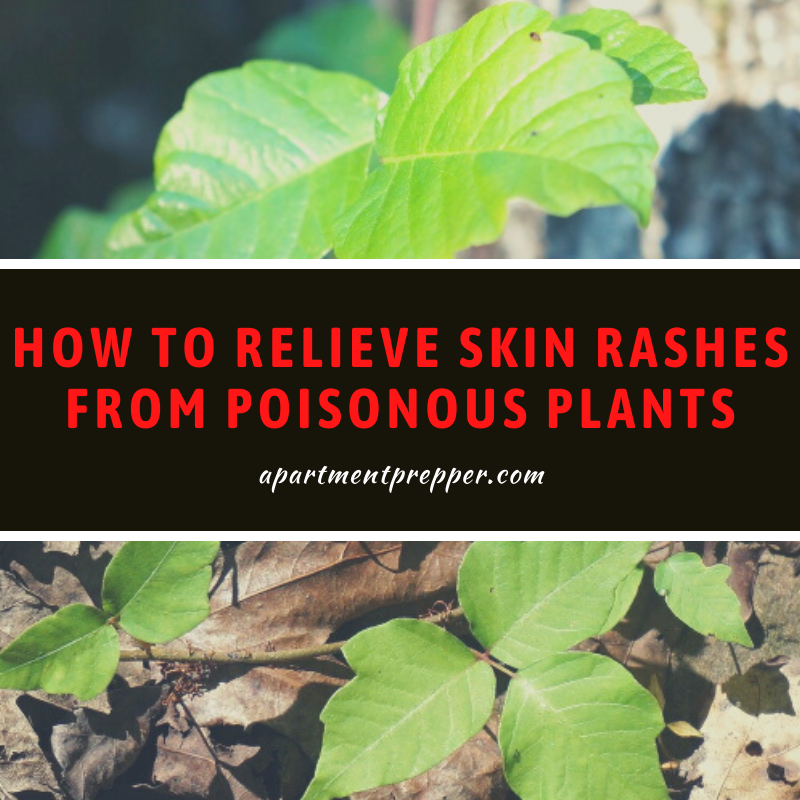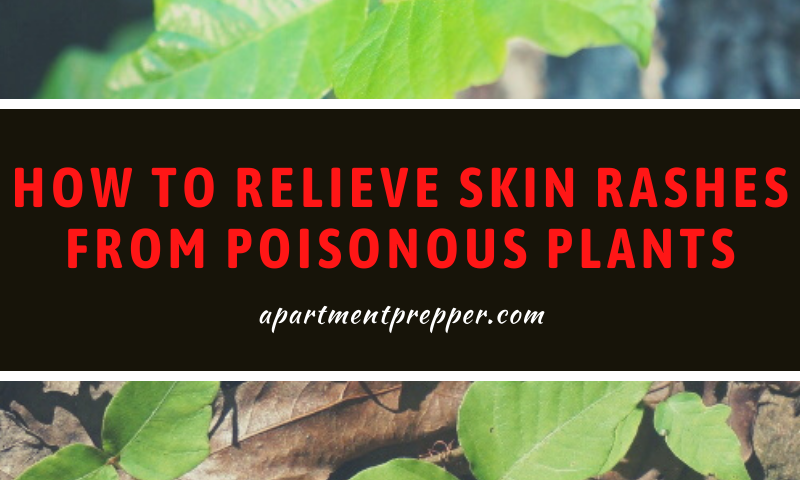This post is by Bernie Carr, apartmentprepper.com
I was checking social media posts when I came across a friend’s update indicating she was exposed to poison ivy during the lockdown and did not have any first aid supplies to deal with it. When you spend time outdoors – hiking, gardening, taking your dog for a walk – there is always a chance you will get exposed to a poisonous plant. It’s a common occurrence year-round but especially during warm weather. Now is a good time to learn some first aid tips and stock up on home remedies.
Poisonous plants
You may have heard the warning “Leaves of three, let it be.” That saying is actually true, according to the Centers for Disease Control (CDC) but it only helps identify two irritating plants: poison ivy and poison oak.
Image by Jan Haerer from Pixabay

Image by Joshua Nichols from Pixabay

Poison sumac does not exhibit “leaves of three.” It normally 7-13 leaves formed in pairs. You may see white berries growing between the leaf and the branch.
Image by Jan Haerer from Pixabay

What these three plants have in common is they contain urushiol oil which can cause itchy rashes or even blisters. Urushiol oil is present in the stems, leaves and roots of poison ivy, poison oak and poison sumac.

Another common irritant is stinging nettle. The leaves and stems of stinging nettle contains sharp hairs that look like tiny hypodermic needles. When these needles come in to contact with skin, the person’s body releases histamine that may cause hives within a few minutes after being exposed.
Symptoms of contact
You can get a bad reaction in various ways:
1. Direct contact with leaves, stems, roots or berries of the plants
2. Indirect contact: You come into contact with something that was contaminated with urushiol oil. For example, you touch a rake that has brushed against the leaves, you retrieve a ball that rolled over some plants or your pet dug up the roots and you touch your pet’s paw. F
3. Airborne contact: Finally, you can also ingest the fumes resulting from burning the plants.
Reactions may not be immediate but may appear in 12 to 48 hours of exposure. Watch for:
- Swelling
- Itching
- Reddish rash
- Patches or streaks of blisters (could be “weeping” or secreting fluids)
First aid treatment
Do not scratch! Scratching only spreads the irritant as your fingers will transfer the oil to other parts of your body. There is also a risk of infection if you have bacteria under your fingernails and you break your skin from scratching.
Poison ivy, poison sumac and poison oak
- Upon discovery, rinse the affected area with rubbing alcohol or de-greasing soap (such as dish-washing liquid) or detergent rinsed with lots of water. Do not leave any soap residue as that may spread the sap even more.
- Take an antihistamine such as Benadryl (diphenhydramine) to help with itching. This may cause drowsiness so avoid driving or operating machinery.
- A wet compress, or calamine lotion may also help relieve itching but do not apply to weeping blisters. The Food and Drug Administration (FDA) recommends applying over-the-counter (OTC) topical corticosteroid preparations
- Or you can soak in colloidal oatmeal.
- The Prepper’s Medical Handbook, by William Forgey, MD, also recommends wet soaks of diluted Epsom salts or even table salts to help dry out weeping lesions.
Stinging nettle
Dr. Forgey recommends an application of mixture of 75% DEET insect repellent and 25% isopropyl “rubbing” alcohol as he’s had good results when he was exposed to stinging nettle.
Other remedies for stinging nettle include:
- Wash the area with soap and water.
- Apply a paste made with baking soda and water
- Aloe vera gel can also help.
- Wet compress or calamine lotion.
- Take an antihistamine such as Benadryl (may cause drowsiness).
Symptoms that require medical attention
First aid tips generally work for most skin rashes, however, there are symptoms to watch out for.
If the skin rash is accompanied by more severe reactions such as difficulty breathing or swallowing, head to the emergency room immediately.
If the rash covers a wide area of the body, see a doctor, as treatment with oral steroids may be required. Other reasons to see a doctor:
- The rash is not improving with over the counter treatments.
- The rash has spread to eyes, mouth or genitals
- Pus has appeared in the blisters
- Fever over 100 F (37.8 C)
Prevention
If you’ve experienced exposure to an irritating plant, how do you avoid contact in the future?
Barrier cream: To prevent irritants from getting into the skin, apply a barrier cream such that contains quaternium-18 bentonite to exposed areas. According the U.S. Forest Service:
A barrier lotion with 5-percent bentoquatam is the only FDA-approved drug that can help prevent contact dermatitis from poison ivy, poison oak, and poison sumac. The bentoquatam is enveloped in a clay-like medium and contained in a lotion that should be applied to the skin at least 15 minutes before exposure to poison ivy, poison oak, or poison sumac. When the lotion dries, it forms a clay-like barrier that protects against or reduces the severity of the rash caused by these plants. Bentoquatam should be reapplied every 4 hours for continued protection. Bentoquatam can be removed with soap and water. It is not recommended for children under the age of 6.
Cover up: I have a lot skin allergies, so I wear lightweight protective clothing when I am outdoors taking a walk, hiking or gardening. Wear long sleeves, long pants tucked into boots and gloves if needed.
Avoidance: Learn to identify plants that cause rashes. Remember “Leaves of three, let it be,” will at least steer you away from the two most common irritants. Even if the plant appears to be dried up or dead, it can still contain urushiol.
DO NOT attempt to burn these plants either, because the oils can be carried through the air and travel for miles. Breathing the fumes can cause severe reactions and can be life threatening.
The final word
Exposure to irritating plants can happen to anyone who spends time outdoors, even if it’s something as simple as taking your dog for a walk. Be prepared to take care of a skin rash by stocking your first aid kit with antihistamine, Calamine lotion, colloidal oatmeal, rubbing alcohol, corticoscoroid cream, DEET (75%) insect repellent, aloe vera gel.
***********************************************************************
We are an affiliate of Amazon.com, which means we received a small commission if you click through one of our Amazon links when you shop, at totally no cost to you. This helps keep the lights on at the blog. Thanks!
About the author:
Bernie Carr is the founder of Apartment Prepper. She has written several books including the best-selling Prepper’s Pocket Guide, Jake and Miller’s Big Adventure, The Penny-Pinching Prepper and How to Prepare for Most Emergencies on a $50 a Month Budget. Her work appears in sites such as the Allstate Blog and Clark.com, as well as print magazines such as Backwoods Survival Guide and Prepper Survival Guide. She has been featured in national publications such as Fox Business and Popular Mechanics. Learn more about Bernie here.



As a child, I had too frequent contact with stinging nettles, our immediate treatment was the juice from the fiddle head fern. We would pick a fern frond and mash it with our fingers, then smear the sap over the stinging nettle “burn”. Nothing else was ever done as treatment. It worked quickly.
Good article. I printed it out to save as reference. Thanks.
Thanks Ron! Appreciate the comment.